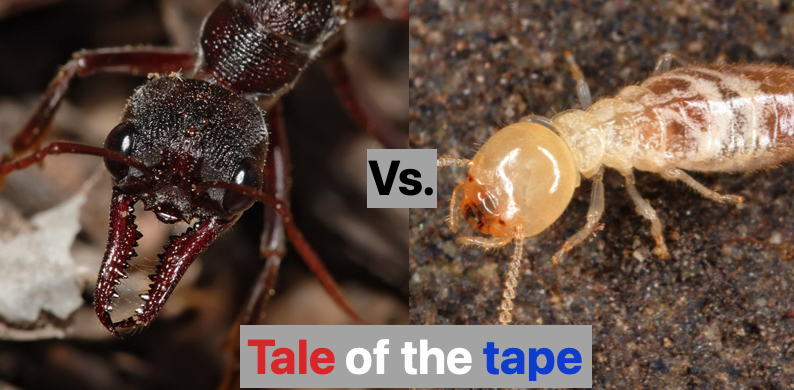Ants vs termites –the rivalry that predates human language — is fought on a global scale. Although termites and ants are both considered pests, many people do not understand that termites and ants are mortal enemies. If nested close, ants and termites engage in war. When it comes to battles of insect proportions, the larger bug doesn’t always win.
Colony vs colony

Milligram for milligram, termites would easily emerge as the winner on a one-on-one fight. They’re larger than ants and have strong, coordinated soldiers as well. Scientists have identified that most termites are two to three times bigger than ants. Also, termites have heads that appear to be built for combat. However, the aspect does not apply when ants and termites wage war. When termites lock horns (no, not literally) with ants, it is usually not close to a fair fight. Termites get annihilated by ants. Despite their size and weight, ants tend to be more aggressive than termites. Termite colonies are numerically inferior ant colonies.
Termites are, in fact, defensive creatures and have no reason to attack ants: they are not interested in the ants’ food; whereas ants will happily use termites AS food and appropriate their tunnels.
In most cases, ants invade termites’ nests and kill the warriors and the queen on sight. The death of a queen virtually is the end of the termite colony. For this reason, some ant species have been known to specifically prey on termites for food.
Termite soldiers last stand

Although ants are generally superior in combat, termites also have an ace up their sleeve. There are unique, blocky adaptations that have been identified among termites’ heads. The heads are defensive, and there are cases where termites throw them up as they try to stop ant attacks. Some species also use them to intimidate intruders and warn the nest. As a last resort, some termites will use their heads to block tunnels into the colony in an attempt to buy the workers time to collapse passages. In most cases, this allows the termite defenders to hold the ant assault and pave new ways for the queen to escape. This last stand sacrifice is the only effective way to keep the queen alive when all else fails.
Lesser of the two evils
Most ants are less damaging to human habitation compared to termites. If you had to choose one or the other, most people would pick the one that doesn’t destroy your property value. People who have studied wars against these pests have been trying to use ants to get rid of termites. However, the practice is not recommended as one would require a supercolony of ants to get rid of all the termites. Using ants to destroy termites’ colonies by killing their queen is not feasible – yet.
Studies have identified that wars cull the old male and female termites from a colony as well. They are used as front-line soldiers when fighting against ants or any other enemy. The senior termites take a colony gate position and prevent enemies such as ants from accessing their queen. In most cases, the female soldiers are sailed forth while engaging ants. The younger soldiers usually stick to the nest and act as the final line of defense while engaging invaders. This aspect indicates that termite soldiers have an age-based task allocation that makes it more difficult for them to be over-powered by ants.
Regardless of the genetic advances termites make, they are no match for the ant. The desire to dominate and get more food is the major reason why ants and termites declare war on each other on sight. To ants, termites are the food.
Feature image: WATM composite, images via Wikimedia Commons


